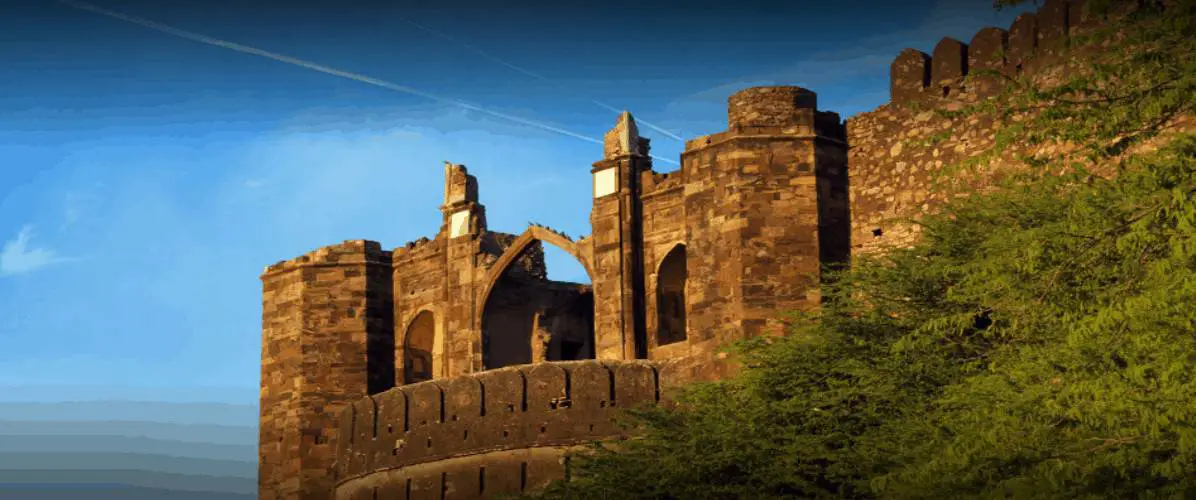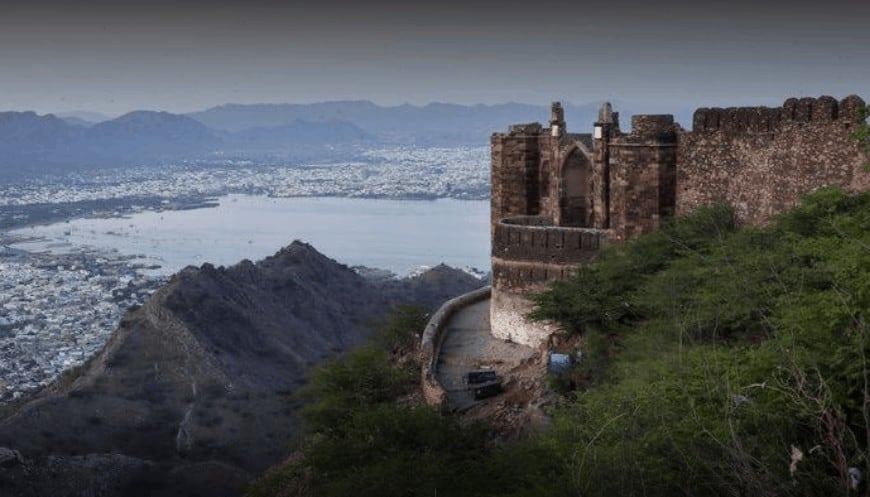Located in the Ajmer district of Rajasthan, Taragarh Fort Ajmer is a historically important fort. This fort is known as Ajmer Fort and Prithviraj Chauhan Fort, Ajmer. The Ajmer fort was built in 1033 AD by the Chauhan king Ajayraj II. Earlier, Chauhan king Ajayraj I of Shyampalak had set up a Chauhan military post in the sixth century here.
Initially, the name was Ajaymere Durg. In 1505, Prince Prithviraj of Mewar took control of it and named it Taragarh in the name of his queen Tarabai.
History of Taragarh Fort, Ajmer, Rajasthan
In the year 1832, Taragarh Fort Ajmer, situated on the highest mountain range of the Rajasthan state of Ajmer district, witnessed the Governor-General of India, William Bentinck, out of his mouth, “Oh, the world’s second Gibraltar and Mughal Emperor Akbar, by finding the superiority of Ajmer, had made the largest diocese of his empire.
The 1,885 feet high mountain peak spread over two square miles spread over one side of the fort, a deep valley on one side, on the other side, three mountain ranges on the other, the slopes of the third slope and the fourth slope of the hill and settled in the foothills of the hill If you look at the vast Ajmer city then it is a very pleasant adventure.
In the strategic control of Mughal north-central India and northern Mughal Rajasthan, Taragarh Fort has the highest importance in the arduous manoeuvring of Marathas, Rathore, and Britishers. Due to the natural security and unique architecture of Taragarh, it was the largest Mughal empire, which at that time had sixty governments and 197 Parganas.
Say that Sultan Muhammad Ghauri was killed in this Taragarh fort by the last Hindu emperor Prithviraj Chauhan (III) of North India. The architecture of Taragarh is unique. From the point of view of architectural architecture in Rajasthan, Kumbhalgarh, Sevana, Ranthambore, Chittorgarh, and Taragarh are unmatched.
Among them, the British generals also accepted the specialisation of the Taragarh fort with open eyes. The unique feature of the fort is the circular wall covering its archway. This is not in any castle of India. There is a small gate to enter. His texture is such that the enemies coming from outside can easily be wiped out and alienated.
On the wall covering the main door, there are fifty rounds to make bullets and arrows from inside. There are 14 turrets all around the fort, on which the Mughals had collected the cannons. These same bastions made the formidable Taragarh invincible.
Therefore, Taragarh, which remained subject, never lost the battle at the door of the fort. Witnessing the Fifteen Wars, the fate of this fort continues to change according to the decisions of the field battle.
In the fortification of Taragarh, fourteen towers have special significance. On the wall of the fort going towards the east from the big door, there are three towers – the veil turret, the dummy turret, and the broken turret. The veil is constructed in a turret-it is not visible from a distance. Nowadays, the government’s wireless is in it.
This type of turret structure is considered important from the point of view of warfare. Next is the carpenter Burj, who says that Hazrat Bullen Shah was killed in the battle with Sayyad Miran Sahi,b so the name of the Burj was recharged by carving. Now the ruins are visible only. Gibson Road to the city passes by itself. After this turret is the Shringar Chauri Burj.
He is the closest to the Lord nowadays. Next to it are four towers- Atta Burj, Peepali Burj, Burj of Ibrahim Shaheed, and Darwai Burj. After this, the Bandra turret, the tamarind turret, the window turret, and the Fatah turret.
In addition to these towers, it is also characterised by a two-kilometre-long battledore of the fort. Two cavalries on this battledore could run comfortably simultaneously. First of all, the entire city must have been within this battledore.

In the tragedy of Taragarh, it will be said that between 1832 and 1920, the British made a huge breakthrough in this, which resulted in nothing but the remains of the torch, broken bastions, the dargah of Miran Sahib, etc.
Besides today, according to the famous historian Diwan Harbillas Sharada of Ajmer, in 1832, the then Governor-General of India, Lord William Mantik, arranged a comprehensive settlement in Taragarh to establish a sanitarium for the treatment of the soldiers of Nasirabad Cantonment. Hence, there remained a sanatorium from 1860 to 1920. From 1033 to 1818, the fort witnessed more than a hundred wars.
After the Chauhan’s, the small war that took place between Afghanistan, Mughals, Rajputs, Marathas, and the British, to keep this fort in their own right can be estimated from these historical facts- 1192 Right of Gauri on the fort, 1202 Lordship of Rajputs, under Sultan Iltutmash in 1226, occupied by Sultan Alauddin Masood in 1242, the rights of Maharana region of Lakhan in 1364, the domination of Chhanda Rathod in 1405, in 1455 The right of Wa Sultan Mahmud Khaliji, possession of Sisodia Rajputs of Mewar in 1505, the authority of Sultan Bahadur Shah of Gujarat in 1535, the domination of King Maldeo of Jodhpur in 1538, possession of Haji Khan Pathan in 1557, the right of the Mughals in 1558, and British authority in 1818.
How to reach the Taragarh fort, Ajmer, Rajasthan
Near Railway Station:- Ajmer 11 KM
Near Airport:- Jaipur Airport 150 KM Via NH 48
Taragarh Ajmer height in km
Taragarh fort is approximately 13oo feet high, which is equal to about 0.4 kilometres above ground level.

My self Dev Satish. I’m an Author and Founder of tourism-rajasthan.com. I’m from Rajasthan and If I talk about my Education then I’m Law Graduate. I love doing work that makes me happy, that’s why I love traveling. you will find Rajasthan travel ideas & tips on this blog.

Hi Satish,
Is this fort open for public visit or by government’s Gress it has been abandoned.
this fort is open for public visit.
Thanks for this very detailed history explanation of Taragarh Fort, and with essential information on how to reach here.
Wow Very Beautiful place. I want to visit that place ♥️♥️
Do we climb up from base… ?